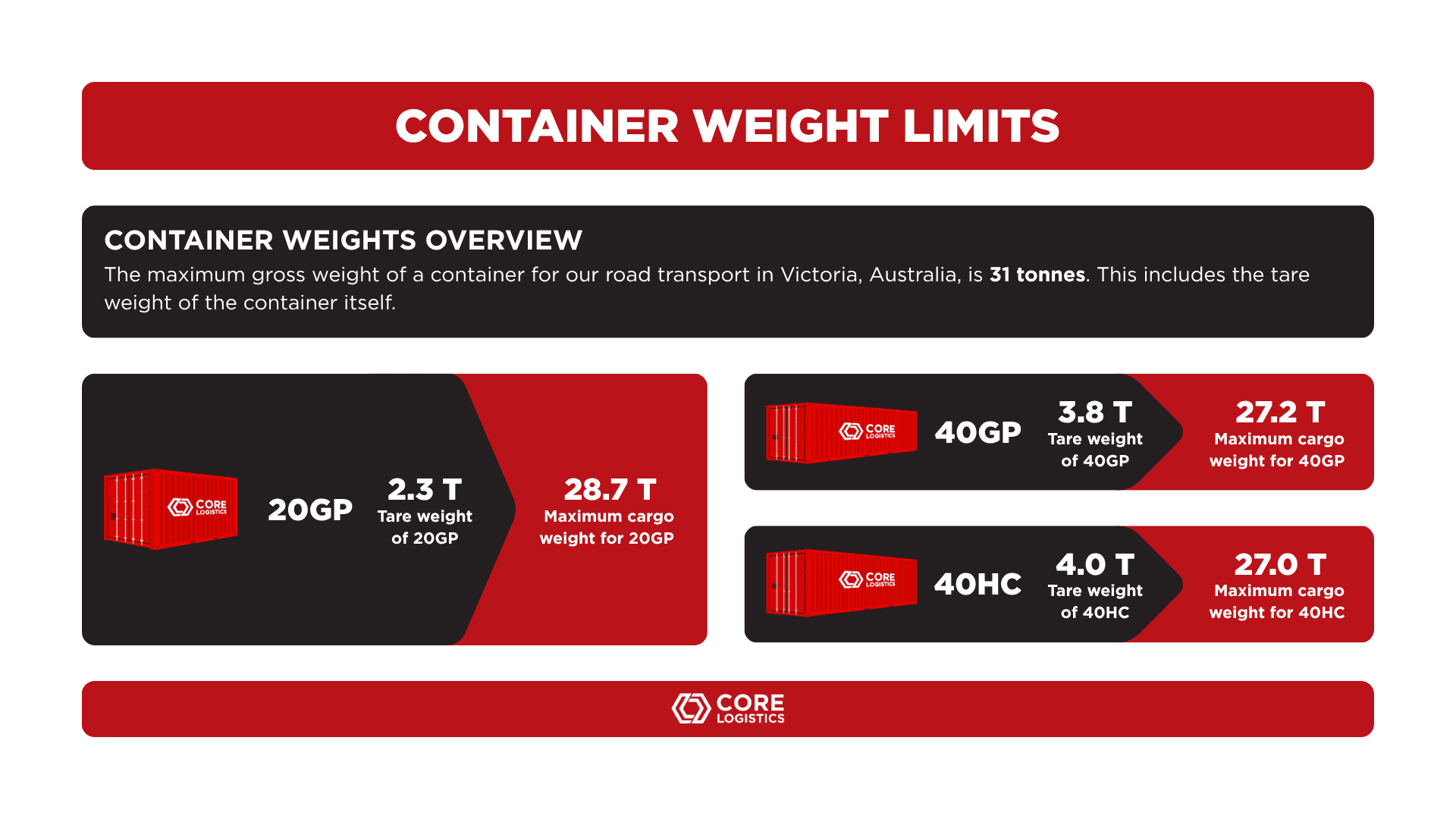Container Weight Limits and Load Guidelines for Transport Operators in Australia

Understanding container weight limits in Australia is crucial for freight forwarders, warehouse managers, and transport operators aiming to stay compliant and avoid costly delays or fines. In Victoria, the maximum gross weight for containers transported by road is 30 tonnes – including the container’s tare weight.
In this guide, Core Logistics breaks down the load limits for common container types, the rules behind them, and how to avoid unnecessary charges.
What is the maximum container weight in Victoria?
The maximum allowable gross container weight for our road transport in Victoria is 31 tonnes. This figure includes both the cargo and the container itself being carried on a prime mover and standard trailer (SKEL) combination. For a sideloader combination, the maximum allowable gross container weight in Victoria is 26 tonnes. Exceeding these maximum weights can result in:
- Mandatory unpacking at terminals
- Additional handling and compliance charges
- Delays in delivery and operational disruptions
How much cargo can I load into a container?
Here are the general cargo weight limits based on typical container tare weights:
- 20GP: Max cargo weight = 28.7 tonnes (tare ~2,300 kg)
- 40GP: Max cargo weight = 27.2 tonnes (tare ~3,800 kg)
- 40HC: Max cargo weight = 27.0 tonnes (tare ~4,000 kg)
If you’re unsure, always confirm the tare weight printed on the container and subtract it from the 30-tonne maximum.
Important: Loading beyond these limits risks additional fees or refusal of pickup. If your cargo exceeds the maximum, it may need to be unpacked at the terminal, incurring extra handling costs.
When do weight-based surcharges apply?
For container deliveries via sideloader, containers with a gross weight over 23.0 tonnes typically attract additional charges. For deliveries via standard trailer (SKEL), this number is 28.0 tonnes. These surcharges are due to the extra resource allocation required to remain compliant with National Heavy Vehicle Regulator (NHVR) regulations.
These costs reflect the strain placed on vehicle configurations, fuel efficiency, and road safety standards under load.
What is the National Heavy Vehicle Regulator (NHVR)?
The NHVR oversees the Heavy Vehicle National Law (HVNL), which applies to all transport operations involving vehicles over 4.5 tonnes. It enforces key requirements around mass, dimension, fatigue management, and vehicle standards.
At Core Logistics, we ensure all container movements comply with NHVR’s strict regulations—keeping you protected from legal and financial penalties.
Why does Chain of Responsibility (CoR) matter?
Chain of Responsibility laws mean everyone in the supply chain—freight forwarders, warehouse staff, consignees, and transport companies—shares legal responsibility for ensuring loads are safe and compliant.
That includes:
- Not overloading containers
- Ensuring weight declarations are accurate
- Properly restraining cargo
If a breach occurs, even administrative staff can be held liable if they contributed to or failed to prevent non-compliance.
How do Load Restraint Guidelines apply?
Australia’s Load Restraint Guide (LRG) outlines best practices for securing cargo within containers and trailers. Improperly restrained loads can:
- Shift during transport
- Damaged goods
- Cause accidents or road breaches
Following these guidelines isn’t just smart – it’s a legal requirement under NHVR laws.
For those that want further information:
https://www.nhvr.gov.au/road-access/loading/load-restraint-guide
Need help planning your next shipment?
If you’re unsure how much your customer can legally load into a container without incurring extra charges, speak to Core Logistics. We’ll confirm weight limits, manage compliance, and coordinate efficient pickup and delivery—ensuring your cargo gets from A to B without a hitch.
Final Takeaway
Stay under 31 tonnes gross weight, always. For sideloader deliveries, keep containers below 23.0 tonnes including container weight if you want to avoid additional charges. Otherwise for SKEL deliveries, keep it under 28.0 tonnes including container weight. Always follow NHVR, CoR, and load restraint guidelines.
Get a Competitive Quote for Container Transport and Storage
Looking for a trusted Melbourne transport company to handle your container transport and storage needs? Core Logistics provides tailored solutions designed to reduce costs while ensuring efficient and reliable transport services.
Contact us today to discuss your requirements.
Call us at +61 3 9315 3204 or fill out our contact form to get started.